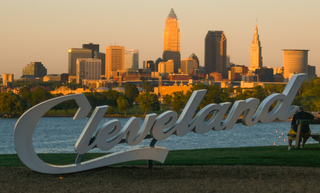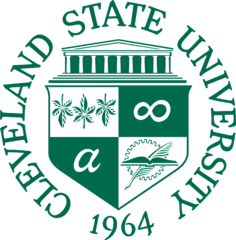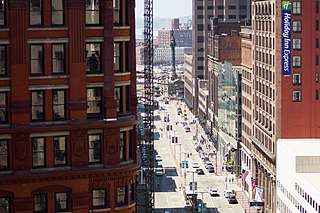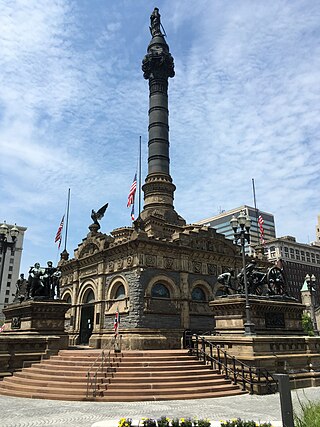Related Research Articles

Cleveland, officially the City of Cleveland, is a city in the U.S. state of Ohio and the county seat of Cuyahoga County. Located in Northeast Ohio along the southern shore of Lake Erie, it is situated across the U.S. maritime border with Canada and lies approximately 60 miles (97 km) west of Pennsylvania.

Oberlin College is a private liberal arts college and conservatory of music in Oberlin, Ohio. Founded in 1833, it is the oldest coeducational liberal arts college in the United States and the second-oldest continuously operating coeducational institute of higher learning in the world. The Oberlin Conservatory of Music is the oldest continuously operating conservatory in the United States. In 1835, Oberlin became one of the first colleges in the United States to admit African Americans, and in 1837, the first to admit women. It has been known since its founding for progressive student activism.

Shaker Heights is a city in Cuyahoga County, Ohio, United States. As of the 2020 census, the city's population was 29,439. Shaker Heights is an inner-ring streetcar suburb of Cleveland, abutting the eastern edge of the city's limits. Shaker Heights was a planned community developed by the Van Sweringen brothers, railroad moguls who envisioned the community as a suburban retreat from the industrial inner city of Cleveland.

Oberlin is a city in Lorain County, Ohio, United States. It is located about 31 miles (50 km) southwest of Cleveland within the Cleveland metropolitan area. The population was 8,555 at the 2020 census. Oberlin is the home of Oberlin College, a liberal arts college and music conservatory with approximately 3,000 students.

Cleveland State University (CSU) is a public research university in Cleveland, Ohio. It was established in 1964 and opened for classes in 1965 after acquiring the entirety of Fenn College, a private school that had been in operation since 1923. CSU absorbed the Cleveland-Marshall School of Law in 1969. Today it is part of the University System of Ohio, has more than 120,000 alumni, and offers over 200 academic programs amongst eight colleges. It is classified among "R2: Doctoral Universities – High research activity".

Cuyahoga Valley National Park is an American national park that preserves and reclaims the rural landscape along the Cuyahoga River between Akron and Cleveland in Northeast Ohio.

Euclid Avenue is a major street in Cleveland, Ohio, United States. It runs northeasterly from Public Square in Downtown Cleveland, passing Playhouse Square and Cleveland State University, to University Circle, the Cleveland Clinic, Severance Hall, Case Western Reserve University's Maltz Performing Arts Center, Case Western Reserve University and University Hospitals Case Medical Center. The street runs through the suburbs of East Cleveland, Euclid, and Wickliffe, to Willoughby as a part of U.S. Route 20 and U.S. Route 6. The HealthLine bus rapid transit line runs in designated bus lanes in the median of Euclid Avenue from Public Square to Louis Stokes Station at Windermere in East Cleveland.

The Cleveland Institute of Art, previously Cleveland School of Art, is a private college focused on art and design and located in Cleveland, Ohio.

Downtown Cleveland is the central business district of Cleveland, Ohio. The economic and symbolic center of the city and the Cleveland-Akron-Canton, OH Combined Statistical Area, it is Cleveland's oldest district, with its Public Square laid out by city founder General Moses Cleaveland in 1796.

Cuyahoga Community College (Tri-C) is a public community college in Cuyahoga County, Ohio. Founded in 1963, it is the oldest and largest public community college within the state. Not until 1961 had Ohio permitted the establishment of community colleges and Ohio was then one of only four U.S. states without them.

Ohio City is one of the oldest neighborhoods in Cleveland, Ohio. It is located immediately west of the Cuyahoga River.

The Cuyahoga County Soldiers' and Sailors' Monument is a major Civil War monument in Cleveland, Ohio, honoring the more than 9,000 individuals from Cuyahoga County who served the Union throughout the war. It was dedicated on July 4, 1894, and is located on the southeast quadrant of Public Square in Downtown Cleveland. It was designed by architect and Civil War veteran Levi Scofield, who also created the monument's sculptures. The monument is regularly open to the public, free of charge.

A Christmas Story House is an attraction and museum in the Tremont neighborhood of Cleveland, Ohio. The 19th-century Victorian, which was used in the exterior and some interior scenes of Ralphie Parker's house in the 1983 film A Christmas Story, was purchased by a private developer in 2004 and has been restored and renovated to appear as it did in the film both inside and outside. The museum is part of a complex of four buildings devoted to the film and is open to the public year round.

Asa Mahan was a U.S. Congregational clergyman and educator and the first president of both the Oberlin Collegiate Institute and Adrian College. He described himself as "a religious teacher and an instructor of youth".

Dr. Harvey Willard Curtiss was a Republican legislator from the U.S. state of Ohio who, as the president of the Ohio Senate, became the 13th lieutenant governor of Ohio 1877–1878 when the governor resigned, and the previous lieutenant governor succeeded to the governorship.

Tremont is a neighborhood on the West Side of Cleveland, Ohio. Listed on the National Register of Historic Places, the district sits just south of the Ohio City neighborhood. It is bounded by the Cuyahoga Valley to the north and east, MetroHealth medical center to the south, and West 25th Street and Columbus Road to the west.
The Cuyahoga County Juvenile Detention Center (CCJDC) is a youth detention center located in Cleveland, Ohio. It is accredited by the American Correctional Association Commission on Accreditation for Corrections. Its average daily population in 2007 was 163 residents, a condition which was described as overcrowded.

Cuyahoga Valley is a neighborhood on the Central and South Side of Cleveland, Ohio, located along the Cuyahoga River. Formerly known as Industrial Valley, the neighborhood was originally limited to only one section of the geographic Cuyahoga River Valley, but the city expanded it in 2012 to include the entire valley area. The present neighborhood includes the Flats and extends from the peninsula of Whiskey Island on Lake Erie in the north to the borders of the suburbs of Newburgh Heights and Cuyahoga Heights in the south. To the east, it borders Downtown Cleveland and the neighborhoods of Broadway–Slavic Village and Central. To the west, it borders the neighborhoods of Detroit–Shoreway, Ohio City, Tremont, and Brooklyn Centre.

Clark–Fulton is a neighborhood on the West Side of Cleveland, Ohio. It is bounded by Ohio City to the north, Tremont to the east, Brooklyn Centre to the south, and Stockyards on the west. The neighborhood, which covers about one square mile, is Cleveland's most densely populated community. In recent years, the neighborhood has begun calling itself La Villa Hispaña due to its large Hispanic population, Puerto Rican and otherwise. The community is focused on advancing and promoting Hispanic-owned businesses and cultural activities.

The Campus District is a Downtown Cleveland, Ohio district that includes the campuses of Cleveland State University, St. Vincent Charity Medical Center, and the Cuyahoga Community College (Tri-C) Metro Campus. Definitions of the district vary. According to the Cleveland City Planning Commission, the district is bounded by Payne Avenue to the north, East 17th Street to the west, and Interstate 90 to the south and east, forming the boundary between Downtown and Cleveland's Central neighborhood. However, the Campus District association places the western boundary of the district to East 18th Street and the eastern boundary further east, to East 30th Street, including Tri-C, with Interstate 77 to the south.
References
- ↑ Oberlin College Archives (2003-03-30). "Biography: Asa Mahan (1799-1889)" . Retrieved 2008-03-27.
- ↑ Tremont History Archives (2008-02-07). "Cleveland University" . Retrieved 2008-03-27.
- ↑ The Encyclopedia of Cleveland History (1997-07-14). "Cleveland University" . Retrieved 2008-03-27.
- ↑ "The People Are the City - Three Cleveland Neighborhoods, 1796-1980 : A Series of Exhibits on Broadway, Hough, and Tremont, during the Summer and Fall of 1980". Board of Cuyahoga County Commissioners, Cuyahoga County Archives. Retrieved 18 March 2012.
- ↑ The Encyclopedia of Cleveland History (1997-06-26). "Humiston Institute" . Retrieved 2008-03-27.
- ↑ Haller, John S. The History of American Homeopathy: The Academic Years, 1820-1935 .